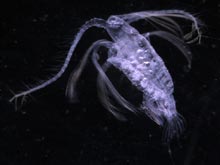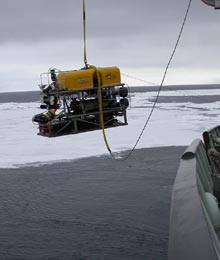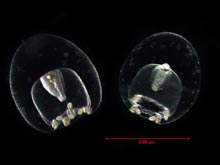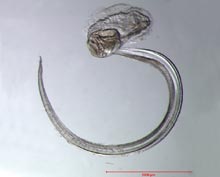
Euaugaptilus hyperboreus is an arctic deep-water copepod. Click image for larger view.
The Global Explorer ROV used during the Arctic 2002 Exploration. It has undergone significant upgrades for this cruise.
Spineless Wonders II: The Pelagic Fauna
Russ Hopcroft
Associate Professor
Institute of Marine Science
University of Alaska, Fairbanks
Overview
What forms of life drift in the world's oceans? For centuries, we have
tackled this question by blindly pulling nets through the water, collecting
primarily the smaller, slower, more numerous, and more robust planktonic
species. Presently, we know a great deal about the more numerous crustacean
zooplankton, such as the copepods (the sea's insects) and euphausiids (krill),
that live in the upper layers of the ocean, but little about deep-water
and fragile life-forms (Image 1). Undoubtedly, we have adequately sampled
only a small fraction of the diversity present, resulting in significant
gaps in understanding the linkages between algal production and the top
predators in the oceans.
Undersea vehicles have vastly expanded our knowledge about behavior, biodiversity and vertical distribution of pelagic animals. Remotely Operated Vehicle (ROV's) and submersibles offer opportunities for direct observations of the species that are normally missed by plankton nets because they are too rare, too fragile, too deep, or too fast for us to catch. In addition, submersible tools can capture live, undamaged specimens of soft-bodied or “gelatinous” animals for further observation or experimental study.
During this expedition, we will search the water column under
the Arctic ice-sheet for rare and new species of zooplankton using a variety
of techniques: Scuba divers, an ROV, and a wide variety of classical and
electronically controlled plankton nets collecting at great depth. We will
create image libraries of living animals, both known and unknown to science,
record their behavior and determine their molecular fingerprints [link
to barcode of life http://www.barcodinglife.com/]. The vertical distribution
and abundance of this fauna will be related to the physical structure of
the water column and that of their potential predators and prey.
Pelagic Fauna in the Arctic
Gelatinous zooplankton range from the weird to the wonderful. Most are fragile
and range from completely translucent to vividly pigmented. Individuals range
in size from only few millimeters to several meters in length, while colonial
forms may string tens of meters in deep-water. These animals are ubiquitous
in the oceans, and many species have persisted for hundred of millions of years,
yet we know relatively little about them. Collecting these animals with nets
usually destroys or breaks them into fragments that are then ignored, discarded,
or misidentified. Equally problematic, conventional preservatives often liquefy
them, leaving behind no identifiable remains.
In contrast, deep-water zooplankton are poorly known not only because many are gelatinous, but because they require more specialized electronic plankton nets, and take much longer to collect. For example, collecting with inexpensive traditional plankton nets to 100m might only take 10-20 minutes, while collecting to 3000m requires more than 3 hours, making you unpopular with shipmates wanting to get to the next station! Such deep-working multiple-net systems divide the water column into pre-determined layers, but the technology involved makes them worth more than the typical automobile, and too pricy for many scientists.
Therefore, it is not surprising that scientists underestimate the basic biodiversity as well as the abundance and biomass of both gelatinous and deep-water animals, especially in Arctic seas where sampling has been limited compared to other parts of the ocean. Historically, most scientists assumed that these soft-bodied zooplankton were unimportant to ecosystem functions, yet recent investigations have demonstrated that they are capable of much higher rates of ingestion, growth, and reproduction than crustaceans. Higher rates allow them to respond more rapidly to shifts in ecosystem productivity. Deep-water species may be present only in low numbers, but when summed over the wide depth ranges in which they live, their importance becomes significant.
On our last expedition
in 2002 we had a number of surprises. Both the ROV and Scuba divers observed
a pronounced layer of fragile ctenophores ![]() in shallow waters. ROV observations revealed that
larger zooplankton were broadly distributed throughout the water column, often
at comparable abundances to other oceans. A probable new species of larvacean
was observed below 2000 m. Even plankton nets revealed a surprisingly high biomass of chaetognaths
in shallow waters. ROV observations revealed that
larger zooplankton were broadly distributed throughout the water column, often
at comparable abundances to other oceans. A probable new species of larvacean
was observed below 2000 m. Even plankton nets revealed a surprisingly high biomass of chaetognaths ![]() (arrow-worms) in the upper 100 m compared to other groups.
On the 2002 cruise, limited sampling opportunities with the ROV, plus limited
depth range on the plankton nets, constrained our efforts to find new species,
although we do have new records for existing species in the central basins
(see
Table below). With more extensive sampling efforts this expedition, we
are poised for greater discoveries.
(arrow-worms) in the upper 100 m compared to other groups.
On the 2002 cruise, limited sampling opportunities with the ROV, plus limited
depth range on the plankton nets, constrained our efforts to find new species,
although we do have new records for existing species in the central basins
(see
Table below). With more extensive sampling efforts this expedition, we
are poised for greater discoveries.
Fun Facts
Gelatinous zooplankton have only 1-10% of the carbon content (per gram wet-weight)
that we typically find in crustacean zooplankton.
Fishing nets were first developed by the siphonophore “jelly-fish”. In the largest genus, Praya, their tentacular nets may be a meter tall, and stretched along a rope-like colony that is 30-40 meters long.
Larvaceans live within large mucus structures called “houses” that they build to help concentrate their food. Up to 20 such structures may be built a day.
At peak burst speed, some copepods move 800 body-lengths per second. Other groups may exceed this rate.
The original stealth technology was invented by ctenophores, which use hundreds of tiny paddles of fused cilia to glide through the water.
The largest members of many zooplankton groups are found in cold or deep waters.
Zooplankton live longer in the Arctic. Groups that typically only live a few weeks in the tropics may live several years in the Arctic.
Deep-water zooplankton are often more brightly colored that shallow water relatives because bright colors cannot be seen at depth by predators.
This expedition contributes to the Arctic Ocean Diversity project (ArcOD) ![]() of the International Census of Marine Life
of the International Census of Marine Life ![]() .
.



































